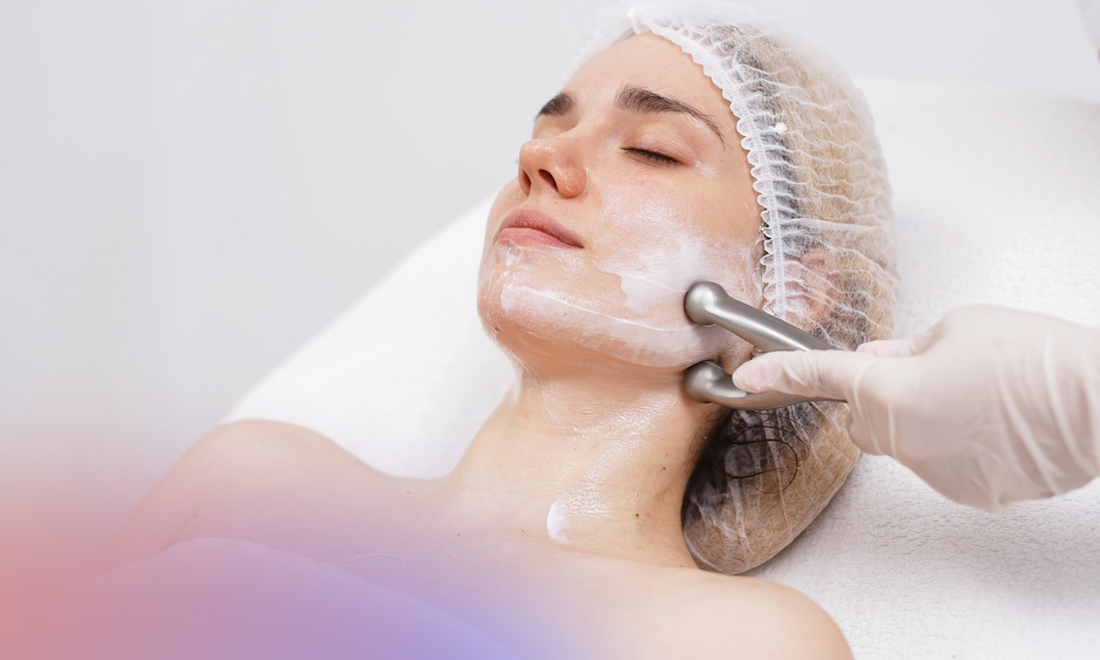Lift and Firm: Your Microcurrent Facial Guide

Anyone willing to forgo pampering in favor of performance is likely already familiar with the face-firming powers of a microcurrent facial. Like LED light therapy, microneedling, and radiofrequency treatments, these beauty gadgets may lack spa-like appeal, but the results can be so compelling that they might just keep you hooked for life.
A quick search for microcurrent facials will reveal numerous “before and after” images that might make you do a double take: the muscle-toning prowess of these high-tech devices is clear to see, even from afar. The lifting effects have even drawn many people away from Botox injections and reduced the appeal of fillers.
But what exactly is microcurrent, and should we be directing it at our faces? Here, experts reveal everything you need to know, from how the technology works to the best at-home microcurrent devices to try.
What is Microcurrent?
Microcurrent was initially used in the 1980s as a treatment to stimulate muscles in people with conditions like Bell’s Palsy. Once the face-lifting side effects were noticed, the beauty industry quickly adopted the technology, and microcurrent facials have been gaining popularity ever since.
“Microcurrent is essentially very low levels of electrical current,” explains facialist Abigail James. “It’s similar to the body’s own bio-electrical field, making it an excellent choice for facial treatments.”
How Does Microcurrent Work?
The electrical current flows between positively and negatively charged conductors. In professional settings, these are usually long, slender rods, while at-home devices like the BodyVital Contour Activator feature more user-friendly spheres. When both are in contact with your skin, the current passes through the muscles, encouraging them to tone up. The focus is on the muscle beneath the skin rather than the skin itself.
To enhance the effectiveness of the microcurrent treatment, it's recommended to use the moisture activating gel. This hydrating serum helps microcurrents penetrate your skin more efficiently, ensuring they reach the facial muscles where they can do the most good.
“The process involves re-educating the muscles: 32 of them, in fact,” says James. However, the low-intensity microcurrent doesn’t achieve this alone. “Such a small amount is used that it’s not capable of manipulating the muscles by itself. That’s why probes, or sometimes electric gloves, which are amazing for hands-on lifting and product penetration, are used. The probes physically move the muscles into the correct position, a process known as re-education,” she explains.
What Are the Benefits of Microcurrent?
As the mild electrical pulses stimulate your facial muscles, they create a more toned and lifted appearance—just like a sculpting gym workout for your face. The benefits are both immediate and cumulative, which is why many people become devoted to this treatment. But lifting isn’t the only advantage.
“Microcurrent’s benefits go far beyond just a lift: it also boosts circulation, enhances the penetration of skincare products, and stimulates collagen and elastin production,” says James. “It even stimulates ATP (adenosine triphosphate), which is muscle energy responsible for key processes such as photosynthesis, muscle re-education, and protein synthesis,” she adds.
To maximize these benefits, consider pairing your microcurrent session with a Reusable T-Zone Mask Pack. This mask is designed to be used with your favorite eye and skin care serums, allowing for better absorption and a more effective treatment.
Are Microcurrent Facials Safe?
According to James, it’s “perfectly safe and effective to start having microcurrent facials in your twenties and continue throughout your adult life.” However, there are a few exceptions.
“If you have epilepsy, are diabetic or pregnant, or have heart issues (such as a pacemaker fitted), microcurrent facials would not be suitable,” James advises. “Likewise, if you have chronic acne, microcurrent may stimulate the inflammation. However, a small spot here or there is usually fine.”
Does Microcurrent Hurt?
Microcurrent isn’t a painful experience. However, clinic treatments vary in intensity, and at higher levels, you may feel a tingling sensation and the occasional ‘jump’ as the current runs through the muscle. At-home devices like the BodyVital Contour Activator use a lower electrical charge, so you shouldn’t feel any discomfort at all.
In-Salon Facials vs. At-Home Devices
The popularity of microcurrent treatments in clinics has led to the emergence of at-home devices, and today, there are several impressive options on the market. However, there are notable differences between in-salon microcurrent facials and at-home alternatives.
James explains that the differences lie in the strength of the current and wavelengths. “They vary dramatically: some professional machines have a variety of wavelengths, which give them more targeted strength. Some also read the amount of energy your skin needs, making the treatment more tailored. You can gradually increase the strength in the clinic as you progress through a treatment course.”
While all at-home microcurrent tools, including the BodyVital Contour Activator, work on a much lower charge than in-salon machinery, results require persistence. Although it takes longer, you can achieve results similar to an in-clinic course at home with regular use.
Microcurrent Devices: The Verdict
While the science behind microcurrent facials is compelling, a bit of anecdotal approval can go a long way before investing in your own device. After road-testing the BodyVital Contour Activator for four weeks, the results have been astonishing. The device offers powerful settings that cause muscle twitches along the cheekbones and jawline, delivering a “snatched” appearance in just a few minutes. The sessions are painless and the results are rapid, even for those with sensitive skin. The BodyVital Contour Activator proves to be a reliable at-home option for achieving a toned and lifted look.

















